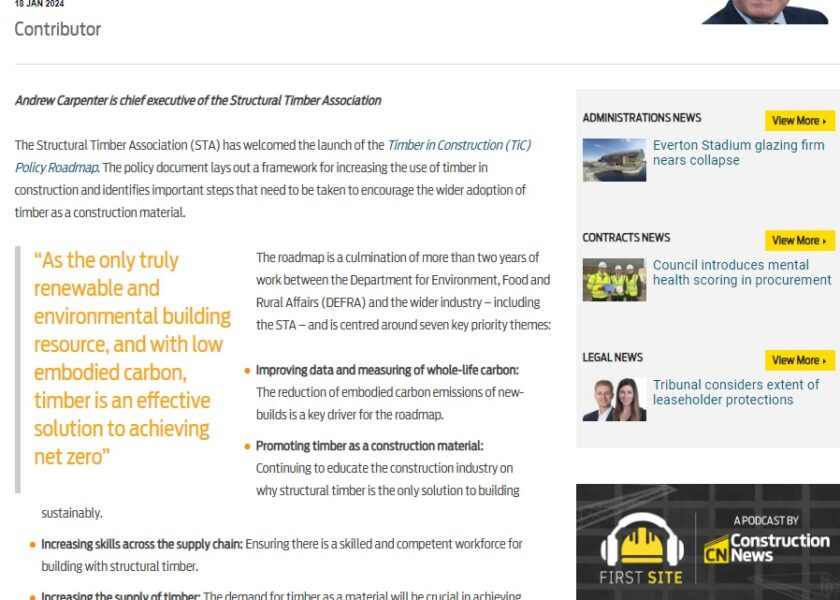The Sustainable Timber Roadmap: a useful starting point
18/01/2024

The STA has welcomed the launch of the Timber in Construction (TiC) Policy Roadmap. The policy document lays out a framework for increasing the use of timber in construction and identifies important steps that need to be taken to encourage the wider adoption of timber as a construction material.
The Roadmap is a culmination of over two years of work between the Department for Environment, Food and Rural Affairs (DEFRA), and the wider industry, including the STA, and is centred around seven key priority themes:
- Improving data and measuring of whole life carbon – the reduction of embodied carbon emissions of new builds is a key driver for the roadmap
- Promoting timber as a construction material – continue to educate the construction industry on why structural timber is the only solution to building sustainably
- Increasing skills across the supply chain – ensure that there is a skilled and competent workforce for building with structural timber
- Increasing the supply of timber – the demand for timber as a material will be crucial in achieving the objectives in the roadmap
- Addressing fire safety – demonstrating how timber frame structures are safe and durable for their application
- Increasing collaboration with insurers and lenders – continue to work with educate the insurance and lending sectors
- Promoting innovation and high performing timber systems – continuing to support innovation and cost-effective timber systems
The increased use of structural timber presents an opportunity to transition towards a more sustainable and carbon-efficient method of construction. As the only truly renewable and environmental building resource, and with low embodied carbon, timber is an effective solution to achieving net zero and for remaining compliant with any future regulatory requirement for energy efficiency.
However, if we are to meet these goals there must be a significant uplift in the number of homes built in timber frame in the UK, which was a fundamental driver outlined in the Policy Roadmap.
Timber acts as an effective carbon store, and at the individual building level, carbon storage is approximately 50% higher in timber-framed homes than in masonry homes. There are a number of skilled and experienced housebuilders who have integrated timber frame manufacture into their own business and are ready for the housebuilding transition to more sustainable materials. Scotland should be used as a key example here, as timber frame has been the building method of choice for many years in fact, in 2019, timber frame was used in 92% of new builds in Scotland, whereas only 9% of new builds in England used the same method, as referenced within the roadmap.
We applaud the leadership that has been shown in setting this objective and in the collaborative approach that has been taken with the industry during the development of this essential policy roadmap. With solid recommendations now in place, the Roadmap will give clarity and reassurance to stakeholders throughout the construction industry.
The STA are looking forward to exploring the actions and next steps from the Roadmap, and as such, have aligned the business strategy to deliver the key actions required of industry to meet the roadmap objectives, focusing most on the demand, skills, carbon and safety themes of the document.
The STA are looking forward to exploring the actions and next steps from the Roadmap, and to continue supporting and participating the alliance across the industry.
It’s important to note that this is a starting point – a very good one, but it is by no means the finished article. What’s required now is the continued determination and collaboration of Government and the industry to make sure we move forward in delivering this.